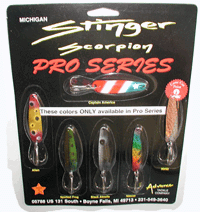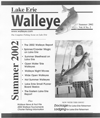|

Scorpion Stinger Spoons

Lake Erie Fishing
Maps

The Official Walleye.com
Lake Erie Walleye
Fishing Hat
|
Walleye Fact File
Corps of Engineers vs.
carp: The fight for the Great Lakes
Asian carp are in for a big shock. The U.S. Army Corps of
Engineers is finishing plans to build a $6.7 million electric fence in the
Chicago Sanitary and Ship Canal to stop the hungry, bottomfeeding fish from
entering Lake Michigan.
If Asian carp crossed into the Great Lakes, they would
pose a greater threat to Lake Erie than any of the other invasive species so
far because they could devastate the perch and walleye fish populations,
said Jeff Reutter, an aquatic nuisance species expert with the Ohio Sea
Grant program. "The result would be fewer perch and walleye in the lake,"
Reutter said. "The dominant species would be the carp."
Asian carp eat up to 40 percent of their body weight
daily, grow up to 1 00 pounds and have no natural predators. They are
working their way up the Mississippi River, where they have displaced other
fish and now represent more than five out of every 10 fish in the river.
Officials from the federal level on down want to contain
the fish so it does not cross into the Great Lakes through the Chicago
Sanitary and Ship Canal, the only direct link between the Mississippi River
and the Great Lakes. The carp escaped from fish farms during floods.
The new fence would be a permanent barrier and would
reinforce a smaller demonstration fence built two years ago, said Charles
Shea, the corps' project manager who was a guest speaker at a three-day
Great Lakes conference in Cleveland this week. The existing barrier is
wearing out. Its cables are corroding and one has failed, Shea said. It was
designed to last three to five years.
Planning is to finish this month and construction will
start in June, he said. The goal is to have the project done by late
September.
Workers will secure up to 50 steel rails to the bottom of
the channel.
Electricity will run through the rails. Like an invisible
fence for dogs, it is designed to make fish feel uncomfortable with an
unpleasant tingle that grows stronger as they swim up the channel. The
intensity will induce fish to turn around. The current, however, will be
safe for human contact.
The corps will put $5 million toward the project and the
state of Illinois will put in $1.7 million.
The project was made a No.1 priority for the corps
earlier this year after senators and representatives from the Great Lakes
states learned the agency planned to delay the project for another year
because of a lack of money.
The corps found the money in its budget.
The new barrier will have two separate sets of rails so if power is lost
to one set, the other set will remain electrified. Each barrier will have a
separate power source as well as backup power in case of a blackout.
Reprinted from The Fishline, a publication of the
Southtowns Walleye Association, the nations largest walleye club.
Castalia's Fish Hatchery
Provide Statewide Trout Angling Opportunities
Each May, the Division stocks 400,000 steelhead trout raised at Castalia in
five of Lake Erie's Central Basin tributaries -Grand, Chagrin, Rocky, and
Vermilion rivers, and Conneaut Creek. These are the trout that have spawned
Ohio's steelhead mania in recent years. They provide a unique fall and
winter stream fishery from October through April, and open water fishing on
Lake Erie during the summer months as these fish migrate between the lake
and the tributaries. (For more information on stream trout fishing, see the
Outdoor Skills article on page 18.)
Steelhead trout eggs are obtained from the Little Manistee River in Michigan
in the spring and raised from eggs. Other steelhead are obtained in the fall
as fingerlings and reared at the hatchery, The hatchery does not currently
have enough incubation and feeding space to start them all from eggs, but
eventually plans to expand production facilities.
Once the steelhead are grown to about nine inches, they are stocked into the
five streams as smolts. (As smolts, trout are at a period in their life
cycle where they imprint on the water source where they were stocked,) Once
in the rivers, they travel into Lake Erie, where they spend two to three
years maturing before they return to the stream to spawn for the first time.
They become a steely-gray color, hence the name steelhead trount
Rainbow trout obtained from London State Fish Hatchery, are also raised
at the Castalia Hatchery for the inland lakes catchable trout program, The
Division stocks 85,000 rainbows measuring 10 to 13 inches in lakes across
the state each spring and 25,000 each fall, creating rare trout fishing
opportunities for local communities. For a list of stocking dates for spring
2004, log on the Division's Web page at
www.ohiodnr.com.
Rainbow trout have been bred for many generations for specific growth and
survival characteristics, explains Insley. They are easy to raise, grow
fast, convert food well, and can withstand warm water temperatures often
associated with Ohio's small inland lakes. They show all the characteristics
of a domestic fish - if approached, they will come to you looking for food.
This makes them a good fish for the inland stocking program as "put and
take" fish. They are expected to be caught easily and within a few weeks of
being stocked.
Steelhead trout, on the other hand, are "wild" fish with a quick flight
response and intolerance for human presence. This leads to long-term
survival, which makes these trout a good fish for the Lake Erie stocking
program. Unlike salmon, these fish do not die after spawning and can live up
to seven years. The state record steelhead trout was caught in Lake Erie in
October 1996 weighing in at 20.97 pounds and measuring 36.5 inches.
As for physical appearance, the London rainbows have a short, fat,
football-shaped body, while the Manistee steelead have a skinnier, longer
appearance, sometimes twice as long as rainbow trout.
This information first appeared in Spring 2004 issue of "Wild Ohio" and
is reprinted courtesy of the Ohio Department of Natural Resources, Division
of Wildlife.
Lake Erie Walleye and Yellow Perch Fisheries Quotas
Announced for 2004
The Lake Erie Committee of the Great Lakes Fishery Commission has reduced
the Total Allowable Catch (TAC) for walleye and increased the TAC for yellow
perch in 2004, according to the Ohio Department of Natural Resources (ODNR)
Division of Wildlife.
The TAC for walleye was set at 2.4 million fish for the 2004 fishing season,
30 percent lower than a year ago, while the yellow perch TAC was increased
by 11 percent over last year to 11 million pounds. The TAC is set in numbers
of adult fish for walleye, but in pounds for yellow perch.
The reduction in the walleye quota reaffirms the commitment by Ohio, other
states and Ontario to rebuild walleye stocks that had fallen to very low
levels after poor reproduction in 2000 and 2002. Anglers will continue to
benefit lake wide from abundant hatches in 1999 and 2001. With conservation
measures in place, a strong hatch in 2003 should boost
numbers of adult fish significantly in coming years.
" Interagency efforts that began in 2001 to rebuild walleye stocks are
ongoing," said Roger Knight, Lake Erie fisheries administrator for the ODNR
Division of Wildlife. "We are very optimistic about major improvements in
the health of Lake Erie walleye stocks over the next few years and expect
better fishing in the immediate future."
The Lake Erie Committee, which consists of fisheries managers from Ohio,
Michigan, Pennsylvania, New York, and Ontario, meets annually to review the
status of walleye and yellow perch and to establish sustainable levels of
catch across the lake.
Walleye
The 2004 TAC will be distributed among four states and the province of
Ontario according to a formula based on the proportional surface area within
the region of Lake Erie designated as prime walleye habitat by the Lake Erie
Committee. Ohio’s share, often referred to as the state’s "quota," will be
about 51 percent of the new TAC, or about 1.2 million fish in 2004. Ontario
receives the next largest quota of about 43 percent, or 1 million walleye.
In anticipation of reduced quotas, nearly all agencies instituted changes in
fishing regulations for 2004. New Ohio regulations include a reduced daily
bag limit during March and April of three fish per person; a 15-inch minimum
size limit in all areas year-round; and a ban on treble hooks in Maumee and
Sandusky bays during the March through April spawning period.
Yellow Perch
Yellow perch populations have responded well to major conservation efforts
by the Lake Erie Committee since the early 1990s. Recent estimates reflect
higher abundance of adult perch throughout most of Lake Erie. A strong hatch
in 2003 is expected to offset a poor hatch in 2002 and maintain relatively
high levels of yellow perch over the next few years.
Of the 11 million pound yellow perch TAC in 2004, the Lake Erie Committee
has issued nearly 7 million pounds in the Central Basin and just under 4
million pounds in the Western Basin of Lake Erie. Ohio’s 2004 quota is about
5.1 million pounds between both of these areas, an increase of about 19
percent over the 2003 quotas. Ontario’s quota is 5.2 million pounds and the
remaining TAC is allocated among Michigan, Pennsylvania, and New York.
"We are extremely pleased to see successful recovery of yellow perch stocks
in Lake Erie, considering where they were just a decade ago," Knight said.
"Perch stocks are showing signs of stability and we expect to have excellent
fishing in 2004."
The 30-fish daily bag limit for anglers and existing commercial fishing
regulations remain in effect for 2004.
|




